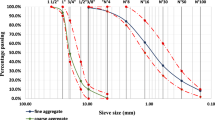Abstract
The oil well sabotage during the Iraqi occupation and following the Iraqi withdrawal contaminated the Kuwaiti desert with crude oil covering millions of square meters. Thus, the desert has a huge amount of oil-contamined sand that must be cleaned up or treated in order to restore it to its natural beauty.
The oil-contaminated sand was utilized to mix asphalt concrete in the laboratory to determine the feasibility of using sand contaminated with oil as feed stock in theproduction of asphalt construction materials. The products developed in experimental testing did meet international standards. The mixes were asphalt concrete of a quality that can be used for secondary roads, road beds, road subbases, impermeable layers for landfill and containment facilities, or as stabilizers for steep embankments. Gases emitted during the production of asphalt concrete utilizing oil-polluted sands are considered environmentally acceptable.
Further studies are required to determine the feasibility of producing asphalt concrete from oil-contaminated sand on a pilot-plant scale as a means of utilizing the millions of square meters of oil-polluted sand.
Résumé
Le sabotage des puits de pétrole pendant l’occupation des forces irakiennes et apr⪻s leur retraite a provoqué la contamination du désert koweïtien par du pétrole brut couvrat des millions de mètres carrés. En conséquence, de vastes quantités de sable contaminé par du pétrole doivent être nettoyées ou traitées afin de restaurer la beauté naturelle du désert.
Le sable contaminé a été utilisé pour faire du béton bitumineux en laboratoire afin d’étudier la possibilité d’utiliser du sable souillé par du pétrole pour produire des matériaux de construction bitumineux. Les produits réalisés lors des essais expérimentaux étaient confrmes aux normes internationales. Les mélanges sont des bétons bitumineux d’une qualité acceptable pour des routes secondaires, des couches de base, des sous-couches, des couches imperméables pour terrains remblayés et décharges, et pour stabiliser des talus de remblais. Les gaz émis lors de la production des bétons bitimineux utilisant des sables pollués sont considérés acceptables du point de vue environnemental.
D’autres études sont nécessaires pour déterminer la viabilité d’une production, à l’échelle d’une installation pilote, de bétons bitumineux à partir des sables contaminées par le pétrole, afin d’utiliser les millions de mètres carrés carrés de sable souillé.
Similar content being viewed by others
References
EPC, ‘A Case Study of Iraqi Regime Crimes Against the Environment’ (Environment Protection Council, Kuwait, 1991).
Al-Besharah, J., Salman, M. and Al-Matrook, F., ‘Characterization and quantification of reclaimable oil from oil lakes formed in Kuwait oil fields’ (Kuwait Institute for Scientific Research, Report No. KISR4081, Kuwait, 1992).
EPRI CS-5261, ‘Remedial Technologies for Leaking Underground Storage Tanks’, (Electric Power Research Institute, Palo Alto, CA, USA).
Preslo, L., Miller, M., Suyama, W., Mclearn, M., Kostecki, P. and Fleischer, E., ‘Available remedial technologies for petroleum contaminated soils’ in ‘Petroleum Contaminated Soils’, Vol. I ‘Remediation Techniques, Environmental Fate, Risk Assessment’ (1989) 115–125.
Czarnecki, R., ‘Making use of contaminated soil’,Civil Engineering 58 (12) (1988) 72–74.
Gunkel, K., ‘Reclaiming petroleum contaminated soil in hot mix asphalt facilities’ in Proceedings, 44th Purdue University Industrial Waste Conference, Chelsea, Michigan (Lewis Publishers Inc., 1990).
Asphalt Institute, ‘Mix design methods for asphalt concrete and other hot mix types’, Manual series No. 2 (MS-2) (1988).
Davis, M.L. and Cornwell, D.A., ‘Introduction to Environmental Engineering’, 2nd Edition (McGraw Hill, Hightstown, N.J., 1991).
Author information
Authors and Affiliations
Rights and permissions
About this article
Cite this article
Al-Mutairi, N.M., Eid, W.K. Utilization of oil-contaminated sands in asphalt concrete for secondary roads. Mat. Struct. 30, 497–505 (1997). https://doi.org/10.1007/BF02524778
Received:
Accepted:
Issue Date:
DOI: https://doi.org/10.1007/BF02524778




